
Clupeiformes is the order of ray-finned fish that includes the herring family, Clupeidae, and the anchovy family, Engraulidae. The group includes many of the most important forage and food fish.

Hyphessobrycon is a genus of freshwater fish in the family Characidae. These species are among the fishes known as tetras. The genus is distributed in the Neotropical realm from southern Mexico to Río de la Plata in Argentina. Many of these species are native to South America; about six species are from Central America and a single species, H. compressus is from southern Mexico.

Franz Steindachner was an Austrian zoologist, ichthyologist, and herpetologist. He published over 200 papers on fishes and over 50 papers on reptiles and amphibians. Steindachner described hundreds of new species of fish and dozens of new amphibians and reptiles. At least seven species of reptile have been named after him.
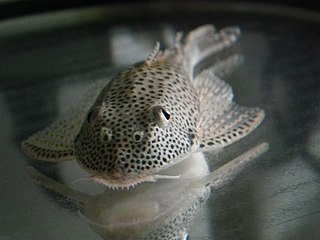
Aphanotorulus is a genus of armored catfishes native to the Amazon, Orinoco, Essequibo and Jaguaribe basins in South America. They typically occur on a sand or gravel bottom in slow to moderately flowing rivers and streams, but some species occur in areas with fast current. The largest species in the genus reaches up to 51 cm (20 in) in standard length.

Gymnothorax is a genus of fish in the family Muraenidae found in Atlantic, Indian, and Pacific Oceans. With more than 120 species, it the most speciose genus of moray eels.

Rineloricaria is a genus of freshwater tropical catfish belonging to the family Loricariidae. They are commonly called whiptail catfish because of the long filament that grows out of the tip of the caudal fin that is characteristic of the genus. With the exception of R. altipinnis from Panama, they are native to the rivers of northern and central South America. Some species are regularly seen in the aquarium trade.

Apogon is a large genus of fish in the family Apogonidae, the cardinalfishes. They are among the most common fish on coral reefs. Over 200 species have been classified in genus Apogon as members of several subgenera. Some of these subgenera, such as Ostorhinchus, have been elevated to genus status, leaving just over 50 species in the genus.
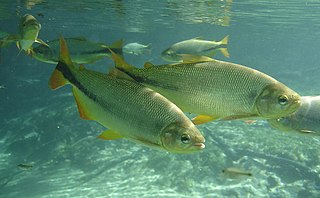
Brycon is a genus of fish in the family Bryconidae and order Characiformes found in freshwater habitats in Central and South America, ranging from southern Mexico to northern Argentina. Despite not being closely related to true trout, they are sometimes called South American trout. Members of the genus may be referred to by a number of other different common names in various languages. They reach a maximum length of 11.9–79.5 cm (4.7–31.3 in) depending on the species involved. Some species perform seasonal breeding migrations.

Thryssa is a genus of anchovies in the family Engraulidae. Some authorities include the species from the genus Thrissina here.

Chaetostoma, also known as the bristlemouth catfish, is a genus of suckermouth armored catfishes native to South America with one species, C. fischeri, extending into Panama. Most species inhabit flowing rivers in the lower Andes and its foothills. Some species are kept in unheated aquaria.

An anchovy is a small, common forage fish of the family Engraulidae. Most species are found in marine waters, but several will enter brackish water, and some in South America are restricted to fresh water.
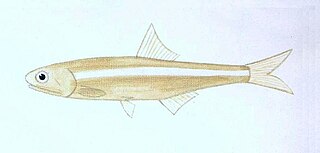
Stolephorus is a genus of ray-finned fish in the family Engraulidae. They are found in Atlantic and Indo-pacific

Anchoa is a genus of ray-finned fishes in the family Engraulidae. It currently consists of 35 species.

Encrasicholina is a genus of ray-finned fish in the family Engraulidae. They are widespread in the Indo-Pacific.

Lycengraulis is a genus of anchovies containing four recognized species. They are restricted to the Western Hemisphere in the waters in and around Central America and South America.

Hemigrammus is a genus of freshwater fish in the family Characidae native to South America and commonly seen in the aquarium trade. These are medium-small tetras where the largest species reach up to around 11 cm (4.3 in).
Cynodonichthys is a genus of freshwater killifish in the family Rivulidae. They are found in Middle America, ranging from southern Mexico, through Central America, to Colombia. They are non-annual killifish and inhabit small forest streams from the lowlands to an altitude of 1,500 m (4,900 ft).
Iguanodectes purusii is a small freshwater fish from the rivers of South America. It is largely herbivorous, and prefers to live in schools. The name "purusii" originates from the species' type locality, the Purus river basin of Brazil, with a range that also extends into Peru. Furthermore, it has been documented from the Amazon, Madeira, Guaporé, and Pastaza rivers, but specific study of its ecology is otherwise lacking.
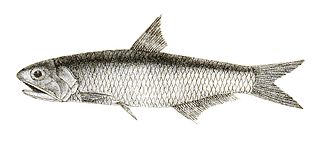
Thrissina is a genus of anchovies in the family Engraulidae. Some authorities regard this genus as invalid, and classify the species as part of Thryssa. FishBase considers eight species as valid.
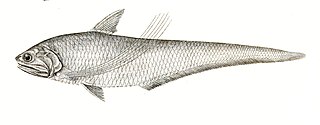
The Ramcarat grenadier anchovy is a species of marine ray-finned fish belonging to the family Engraulidae, the anchovies. This species is found in the northern Indian Ocean.

















